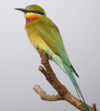INTRODUCTION
Having previously only heard a Corncrake fourteen years ago in Hungary, we decided it was about time we made an effort to see the species. After a brief trawl of the internet, we concluded Tiree would provide us with the best opportunity to fulfil our ambition. We settled on an itinerary and made our travel arrangements at the beginning of February 2014 to (hopefully) coincide with the arrival of Corncrakes from their East African wintering grounds.
TRAVEL, ACCOMMODATION & FOOD
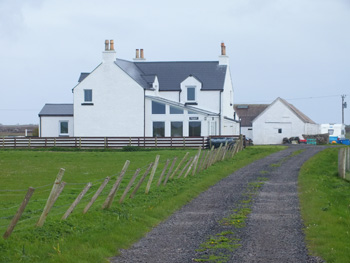 With a 6/7 hour journey to catch the ferry at Oban we decided to bookend our trip with a couple of cheap nights at Premier Inns at Fort William on the way out and Dumfries on the return leg so that we could visit a couple of gardens & plant nurseries around Kirkcudbright and Gate of Fleet. For the middle three nights on Tiree we decided to stay at the Rockvale Guest House (01879 220675) on Balephetrish Bay. Rockvale gets a good write-up on Trip Advisor and lived up to its reputation. The property is well situated for travel around the island: we were given a warm welcome on arrival and were well looked after by Alison Campbell and Tina (who also works at the Céabhar Restaurant). The accommodation was spacious, modern and very comfortable and was matched in quality by the excellent breakfasts - altogether a perfect choice.
With a 6/7 hour journey to catch the ferry at Oban we decided to bookend our trip with a couple of cheap nights at Premier Inns at Fort William on the way out and Dumfries on the return leg so that we could visit a couple of gardens & plant nurseries around Kirkcudbright and Gate of Fleet. For the middle three nights on Tiree we decided to stay at the Rockvale Guest House (01879 220675) on Balephetrish Bay. Rockvale gets a good write-up on Trip Advisor and lived up to its reputation. The property is well situated for travel around the island: we were given a warm welcome on arrival and were well looked after by Alison Campbell and Tina (who also works at the Céabhar Restaurant). The accommodation was spacious, modern and very comfortable and was matched in quality by the excellent breakfasts - altogether a perfect choice.
Caledonian MacBrayne Ferries (08000 665000) run a daily service operating out of Oban, to and from Coll & Tiree, but ferry times vary. The cost for the two of us, with our vehicle, was £148.60. Booking in advance is recommended, especially if you are taking a vehicle. Both trips went smoothly and were uneventful with the sea quite calm, especially on the return leg.
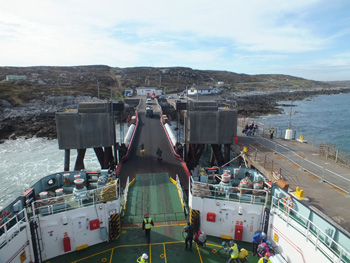 As you would expect with a small, remote island, evening dining options are somewhat limited and it is best to book in advance, rather than be disappointed on the night. We arrived on Tuesday and the only dining option was the Scarinish Hotel (01879 220308). Having seen the reviews on Trip Advisor we were a little apprehensive; however, thankfully the food was not as black as painted. It was nothing special, but was quite satisfactory. Unfortunately, the same could not be said for the lunch we had there on Thursday, which was a little disappointing to say the least, as was the service. On Wednesday and Thursday evenings we dined at the Céabhar Restaurant, Sandaig (01879 220684) which was an altogether more enjoyable experience. There is a good atmosphere here, matched by quality food and excellent service. At lunchtime on Wednesday we dined at the Cobbled Cow Tearoom (01879 220096) situated in the Tiree Rural Development Centre at Crossapol, near the airport, which also provides another alternative for an evening meal. The food was quite good and there is a varied menu, but it is a tearoom rather than a restaurant. There are public loos at the Development Centre as well as in Scarinish.
As you would expect with a small, remote island, evening dining options are somewhat limited and it is best to book in advance, rather than be disappointed on the night. We arrived on Tuesday and the only dining option was the Scarinish Hotel (01879 220308). Having seen the reviews on Trip Advisor we were a little apprehensive; however, thankfully the food was not as black as painted. It was nothing special, but was quite satisfactory. Unfortunately, the same could not be said for the lunch we had there on Thursday, which was a little disappointing to say the least, as was the service. On Wednesday and Thursday evenings we dined at the Céabhar Restaurant, Sandaig (01879 220684) which was an altogether more enjoyable experience. There is a good atmosphere here, matched by quality food and excellent service. At lunchtime on Wednesday we dined at the Cobbled Cow Tearoom (01879 220096) situated in the Tiree Rural Development Centre at Crossapol, near the airport, which also provides another alternative for an evening meal. The food was quite good and there is a varied menu, but it is a tearoom rather than a restaurant. There are public loos at the Development Centre as well as in Scarinish.
Alternatives which we did not try are the Tiree Lodge Hotel, Gott Bay (01879 220329) and the Farmhouse Café at Balemartine which is open from 11.00am to 4.00pm.
Driving around the island is mainly on single track roads with numerous passing places. Whilst we were there, traffic was quite light and if we wished to stop to enjoy a view or watch a bird, we could usually find somewhere to pull off the road without causing a traffic jam or aggravating the locals.
RESEARCH & USEFUL INFORMATION
Tiree
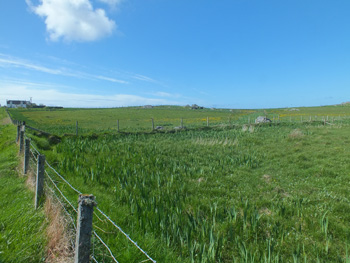 Tiree lies in the far north west of Argyll & Bute at the south end of the Minch. It is c20 km long & 5 km wide and is rather flat and open to the elements. Shell-sand has blown over much of the island to form extensive herb-rich machair grasslands, grazed by cattle and sheep. The machair lands and adjacent wet grasslands and beaches host high densities of breeding waders whilst the areas that are cropped for grass in late summer are home to a substantial proportion of the UK’s Corncrakes. When we were there we were advised c50 calling males had already made it back to Tiree. The island’s flat, convoluted coastline holds internationally important numbers of wintering waders and the large machair lochs are home to important groups of both breeding and wintering wildlfowl.
Tiree lies in the far north west of Argyll & Bute at the south end of the Minch. It is c20 km long & 5 km wide and is rather flat and open to the elements. Shell-sand has blown over much of the island to form extensive herb-rich machair grasslands, grazed by cattle and sheep. The machair lands and adjacent wet grasslands and beaches host high densities of breeding waders whilst the areas that are cropped for grass in late summer are home to a substantial proportion of the UK’s Corncrakes. When we were there we were advised c50 calling males had already made it back to Tiree. The island’s flat, convoluted coastline holds internationally important numbers of wintering waders and the large machair lochs are home to important groups of both breeding and wintering wildlfowl.
The whole island could loosely be described as one large birding site; however, we felt certain areas offered better prospects than others:-
Balemartine and the area west towards Balinoe and Balephuil is one of the best for Corncrakes.
Mannal to Hynish coastline was always worth a look from any convenient roadside pull-off.
Balephetrish Bay (NM005471), Gott Bay (NM043469), Balevullin Bay (NL952475) & Sorobaidh Bay (NL995425) always contained good numbers of waders on passage, terns and divers.
Loch a’ Phuill (NL956418), Loch an Eilein (NL984436) & Loch Bhasapol (NL971469) contained small numbers of waterbirds and would have much more potential over winter.
Traigh Bhagh/The Reef (NM006438) is a sandy bay, backed by dunes and machair. Although there is no access to The Reef itself, the machair plain can be viewed from the road and dunes.
Weather
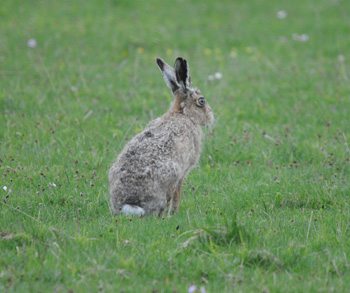 Forecasts can be found at both BBC & Met Office web sites along with more comprehensive details at Windguru a surfing web site based in the Czech Republic.
Forecasts can be found at both BBC & Met Office web sites along with more comprehensive details at Windguru a surfing web site based in the Czech Republic.
Whilst we were there the forecast was mainly sunshine & showers and, true to form, it was also a little breezy. In the main we didn’t need our rain gear as we managed to dodge the showers, the worst of which were late in the evening or overnight.
Contacts
John Bowler is the RSPB Officer based on Tiree at Balephuil (01879 220748 or mobile 07743 841421 or email). Having spent a fruitless morning (about 4 hours) listening to Corncrakes but not seeing any, we left a message for John to see if he could help with any locations where the birds were particularly showy. He called us back within the hour with some advice: the phone rang just as we had spotted our first Corncrake, co-incidentally at one of the sites he had recommended in the message he left for us.
Simon Wellock currently runs Wild Tiree (01879 220101 or email), but whilst we were there we were advised he was leaving the island in the near future.
Information and sightings
Argyll Bird Club - Coll & Tiree
Mullbirds - Sightings from Tiree
Finding Birds on Tiree - A Guide by John Bowler is a useful pamphlet widely available on the island.
Birds of Tiree & Coll by John Bowler and Janet Hunter is available on the island for £9 and also by mail order.
Maps
Ordnance Survey Landranger Series Maps (1:50,000) number 46
Ordnance Survey Explorer Series Maps (1:25,000) number 372
However, we managed with the map in the freely available booklet “Tiree - a Visitors Map of the Island” plus a map of the Special Protection Area set aside for Corncrakes which I found online.
Mobile Phones
The only service providers on the island are O2 and Vodaphone and, even here, the signals come and go.
DIARY
Monday 5th May: Journey to Scotland - o/n Fort William.
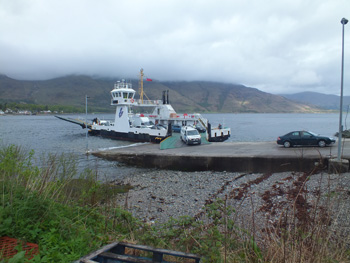 Driving north, we came across our first 3 Hooded Crow at Loch Lomond and saw a single Osprey fishing one of the roadside lochs on the A82 about half way between Loch Lomond and Glencoe. At one point a small herd of c20 Red Deer browsed the hillside adjacent to the road. Getting a little desperate as we hadn’t spotted anywhere to have lunch, we stopped at Bonnie Braes, about half way along the shores of Loch Lomond. Honestly…. don’t bother! It’s a bit of a dump and the food’s worse. There are lots of better eating options a little further on at Crianlarich and nearby Tyndrum.
Driving north, we came across our first 3 Hooded Crow at Loch Lomond and saw a single Osprey fishing one of the roadside lochs on the A82 about half way between Loch Lomond and Glencoe. At one point a small herd of c20 Red Deer browsed the hillside adjacent to the road. Getting a little desperate as we hadn’t spotted anywhere to have lunch, we stopped at Bonnie Braes, about half way along the shores of Loch Lomond. Honestly…. don’t bother! It’s a bit of a dump and the food’s worse. There are lots of better eating options a little further on at Crianlarich and nearby Tyndrum.
Even though we had had a long drive it was only mid-afternoon by the time we neared Fort William so we decided to take the Corran Ferry across Loch Linnhe and drive around the Ardnamurchan Peninsula. With quite a bit of single track roads, this took us a little longer than anticipated but, in our view, was well worth it. We turned left off the ferry and followed the A861 west, prior to heading north just before Archaracle and finally meeting the A830 at the end of Loch Ailort and turning east to Fort Willam. As we waited for the ferry, which runs at 20 minute intervals, we spotted Siskin and Goldfinch feeding on the seed heads in the grass verge whilst 3 Black Guillemot patrolled the Loch between the two piers. 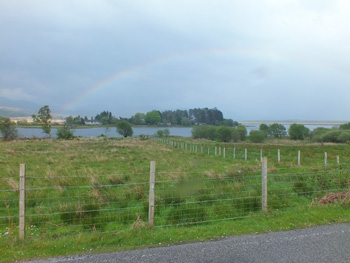 Not long after getting off the ferry (we were the first) we pulled in to a convenient spot overlooking Loch Linnhe to let the rest of the ferry traffic pass us and to scope out the nearby shoreline. Common Gull were the most numerous species, but we also spotted a few Ringed Plover and a single Common Sandpiper, whilst out on the water both Great Northern Diver and Red-throated Diver were present. Three Raven flew overhead whilst a male Hen Harrier flew purposefully across the loch and we were serenaded by Willow Warbler in the nearby trees. Even though there was a light drizzle of rain it felt good to be away and out birding. As we approached Loch Sunart we spotted a pair of Golden Eagle above the trees on a nearby ridge and were able to watch them for a few minutes before first one, then the other dived rapidly out of sight behind the hill. We briefly spotted a Redstart as it disappeared into the bushes and saw the occasional lingering Whooper Swan on the small roadside lochs before arriving at Loch Moidart where we were delighted to find another Great Northern Diver close to the shore, along with 6 Red-breasted Merganser, as a Cuckoo called in the distance. We didn’t see much of interest for the last 30 miles or so - time was getting on, the roads had improved and dinner was definitely calling.
Not long after getting off the ferry (we were the first) we pulled in to a convenient spot overlooking Loch Linnhe to let the rest of the ferry traffic pass us and to scope out the nearby shoreline. Common Gull were the most numerous species, but we also spotted a few Ringed Plover and a single Common Sandpiper, whilst out on the water both Great Northern Diver and Red-throated Diver were present. Three Raven flew overhead whilst a male Hen Harrier flew purposefully across the loch and we were serenaded by Willow Warbler in the nearby trees. Even though there was a light drizzle of rain it felt good to be away and out birding. As we approached Loch Sunart we spotted a pair of Golden Eagle above the trees on a nearby ridge and were able to watch them for a few minutes before first one, then the other dived rapidly out of sight behind the hill. We briefly spotted a Redstart as it disappeared into the bushes and saw the occasional lingering Whooper Swan on the small roadside lochs before arriving at Loch Moidart where we were delighted to find another Great Northern Diver close to the shore, along with 6 Red-breasted Merganser, as a Cuckoo called in the distance. We didn’t see much of interest for the last 30 miles or so - time was getting on, the roads had improved and dinner was definitely calling.
Tuesday 6th May: Fort William to Oban & 14.45 ferry to Tiree (arrived at 18.25) - o/n Rockvale Guest House for 3 nights.
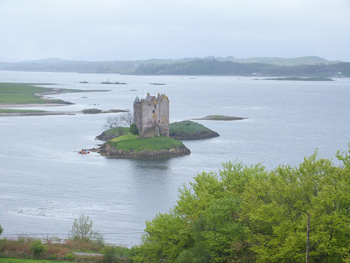 After a leisurely breakfast we left Fort William for Oban just after 10am and enjoyed the scenery as we motored south down the shore of Loch Linnhe. We crossed Loch Etive at Connel and left the A85 for minor road No 78 heading inland towards Loch Nell. We had hoped we might see Whinchat here, but we had no luck; we had to be content with Yellowhammer, numerous Willow Warbler, a small flock of Rook and a pair of Goosander before returning to the main road south of Oban and heading for the ferry terminal and a spot of lunch at the Kitchen Garden Delicatessen and Coffee Shop which is highly recommended. As we set sail there was a single Black Guillemot in the harbour, but despite remaining on deck for most of the 3½ hour trip, birds were far and few between. Sailing between Mull and the Ardnamurchan Peninsula we watched a pair of Golden Eagle over the mainland along with distant gulls & terns over the water. A pair of Razorbill provided the only other bit of interest during the first two hours and it wasn’t until we left Ardnamurchan behind that we spotted the first of about 20 Manx Shearwater gliding over the waves. We had seen the occasional Shag and as we neared Coll we also spotted 2 Gannet, 2 Fulmar and a single Kittiwake. Although we didn’t have much time to spare between booking in at Rockvale and dinner at the Scarinish Hotel, it was obvious once we were on Tiree that we would soon be enjoying our birding with a greater variety of species quickly in evidence: Shelduck, Linnet, Meadow Pipit, Song Thrush, 2 Whimbrel, Sanderling, Redshank and Whooper Swan, along with 4 gull species were spotted in a quick drive around the centre of the island in the gathering gloom as rain set in for the evening.
After a leisurely breakfast we left Fort William for Oban just after 10am and enjoyed the scenery as we motored south down the shore of Loch Linnhe. We crossed Loch Etive at Connel and left the A85 for minor road No 78 heading inland towards Loch Nell. We had hoped we might see Whinchat here, but we had no luck; we had to be content with Yellowhammer, numerous Willow Warbler, a small flock of Rook and a pair of Goosander before returning to the main road south of Oban and heading for the ferry terminal and a spot of lunch at the Kitchen Garden Delicatessen and Coffee Shop which is highly recommended. As we set sail there was a single Black Guillemot in the harbour, but despite remaining on deck for most of the 3½ hour trip, birds were far and few between. Sailing between Mull and the Ardnamurchan Peninsula we watched a pair of Golden Eagle over the mainland along with distant gulls & terns over the water. A pair of Razorbill provided the only other bit of interest during the first two hours and it wasn’t until we left Ardnamurchan behind that we spotted the first of about 20 Manx Shearwater gliding over the waves. We had seen the occasional Shag and as we neared Coll we also spotted 2 Gannet, 2 Fulmar and a single Kittiwake. Although we didn’t have much time to spare between booking in at Rockvale and dinner at the Scarinish Hotel, it was obvious once we were on Tiree that we would soon be enjoying our birding with a greater variety of species quickly in evidence: Shelduck, Linnet, Meadow Pipit, Song Thrush, 2 Whimbrel, Sanderling, Redshank and Whooper Swan, along with 4 gull species were spotted in a quick drive around the centre of the island in the gathering gloom as rain set in for the evening.
Wednesday 7th May: Tiree
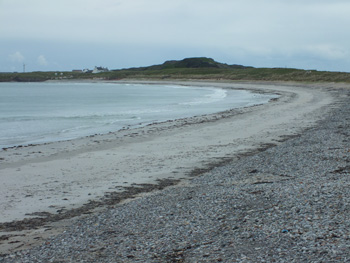 After an excellent breakfast we left Rockvale at c09.15 and went to the nearby Balephetrish Bay. Wheatear and Hares lined the roadside whilst the shoreline contained good numbers of migrating Sanderling, Turnstone, Ringed Plover and Dunlin, many of which were resplendent in summer plumage. Several Great Northern Diver and c10 Red-breasted Merganser were preening and fishing in the bay with attendant Arctic Tern and a couple of Little Tern joining Fulmar and 5 species of gull. The occasional seal surfaced as we watched and both species and numbers were to form a common theme for most of the bays we visited.
After an excellent breakfast we left Rockvale at c09.15 and went to the nearby Balephetrish Bay. Wheatear and Hares lined the roadside whilst the shoreline contained good numbers of migrating Sanderling, Turnstone, Ringed Plover and Dunlin, many of which were resplendent in summer plumage. Several Great Northern Diver and c10 Red-breasted Merganser were preening and fishing in the bay with attendant Arctic Tern and a couple of Little Tern joining Fulmar and 5 species of gull. The occasional seal surfaced as we watched and both species and numbers were to form a common theme for most of the bays we visited.
We quickly moved on past the airport towards Balemartine and our main quarry, stopping briefly for Tufted Duck and both Whooper & Mute Swan at Loch an Eilein on the way. Over the next 2 hours we heard at least 10 calling male Corncrake between Balinoe Graveyard and Hynish with the largest concentration being around Balemartine and Mannal. Several Eider were close to the shoreline at Hynish along with Shag, Shelduck, 2 Guillemot and the occasional Gannet, whilst we spotted the occasional Sand Martin amongst the Swallows overhead and Twite, House Sparrow and Linnet were common along the roadsides.
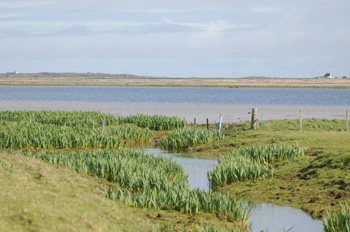 We then took the road to Balephuil and Loch a Phuill where we saw our first of many roadside Snipe. At the Loch Redshank and good numbers of Ringed Plover and Dunlin were busy feeding on the surrounding cropped grasslands, but apart from Mute Swan and Tufted Duck, there was little on the water. Hooded Crow & Raven were quite common overhead along with the occasional Buzzard and near Heylipol we spotted a lone male Shovelor on a small farmyard pool. By now it was c13.15 and we headed to the Cobbled Cow Tearoom for a spot of lunch. Nearby a single Collared Dove flew overhead; a change from the Rock Doves which are common on the island. Over lunch we considered our options, as by now, we were getting pretty anxious about our ability to spot a Corncrake despite the numbers calling all around us at times. In desperation we decided to call John Bowler to see if he could offer any tips, but we had to leave a message for him.
We then took the road to Balephuil and Loch a Phuill where we saw our first of many roadside Snipe. At the Loch Redshank and good numbers of Ringed Plover and Dunlin were busy feeding on the surrounding cropped grasslands, but apart from Mute Swan and Tufted Duck, there was little on the water. Hooded Crow & Raven were quite common overhead along with the occasional Buzzard and near Heylipol we spotted a lone male Shovelor on a small farmyard pool. By now it was c13.15 and we headed to the Cobbled Cow Tearoom for a spot of lunch. Nearby a single Collared Dove flew overhead; a change from the Rock Doves which are common on the island. Over lunch we considered our options, as by now, we were getting pretty anxious about our ability to spot a Corncrake despite the numbers calling all around us at times. In desperation we decided to call John Bowler to see if he could offer any tips, but we had to leave a message for him.
After lunch we decided to return to Balemartine and try the dead-end road at the start of the settlement, just after the Balephuil turn off. The turning is a little concealed and is by the white cottage named “Cnoc Mor”: if you reach the Blue Beyond Gallery you have gone too far. Almost immediately we heard and then spotted a Sedge Warbler and once again heard Corncrake calling at either side of the road. 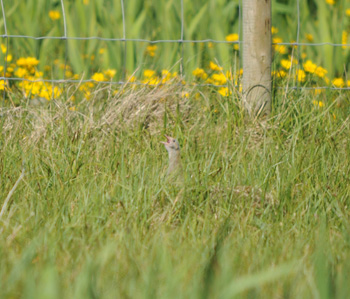 As we tried to locate the birds that were calling, Amanda noticed two likely looking suspects dashing across the road about 100 metres ahead. We crawled ahead slowly and stopped by a small fenced field where we suspected the birds had gone. Almost at once one started calling and as I got out of the car, I spotted movement at the back of the field, less than 50 metres away. All of a sudden there it was, head and shoulders peering through the grass as it gave vent to its feelings. I looked away to point out the spot to Amanda but the bird had disappeared; then the phone rang (bugger) - I ignored it and looked back to find the bird again, a little further along the fence line. We both enjoyed the bird for 2 or 3 minutes and I managed to get a few hurried photos. When it finally disappeared into the undergrowth I looked at my phone to find the missed call was John Bowler. I phoned him at once to find he had left a message with a couple of possible sites - one of which we were actually at. Thanking him copiously and flushed with having found our own Corncrake, we moved on towards the opposite end of the island.
As we tried to locate the birds that were calling, Amanda noticed two likely looking suspects dashing across the road about 100 metres ahead. We crawled ahead slowly and stopped by a small fenced field where we suspected the birds had gone. Almost at once one started calling and as I got out of the car, I spotted movement at the back of the field, less than 50 metres away. All of a sudden there it was, head and shoulders peering through the grass as it gave vent to its feelings. I looked away to point out the spot to Amanda but the bird had disappeared; then the phone rang (bugger) - I ignored it and looked back to find the bird again, a little further along the fence line. We both enjoyed the bird for 2 or 3 minutes and I managed to get a few hurried photos. When it finally disappeared into the undergrowth I looked at my phone to find the missed call was John Bowler. I phoned him at once to find he had left a message with a couple of possible sites - one of which we were actually at. Thanking him copiously and flushed with having found our own Corncrake, we moved on towards the opposite end of the island.
On the way, in and around Crossapol Bay, we spotted c20 migrating Whimbrel roosting on the rocks. We saw little at Caolas and on Gunna Sound, the narrow stretch of water separating Tiree from Coll, but as we returned towards Salum 5 Bar-tailed Godwit circled overhead before flying in the direction of Salum Bay. We followed suit and in the bay saw the usual suspects including two roosting Little Tern but no Godwits. As we returned along the wide stretch of white sands of Gott Bay we were enthralled by huge flocks of c500 Dunlin and c300 Sanderling feeding on the shoreline. We returned to Rockvale at c16.50 to relax a little before going out to Sandaig and the Céabhar Restaurant at 19.00. Returning to Rockvale, fully replete at c20.30 we spotted 4 White Wagtail and 2 male Pheasant near Cornaigmore.
Thursday 8th May: Tiree
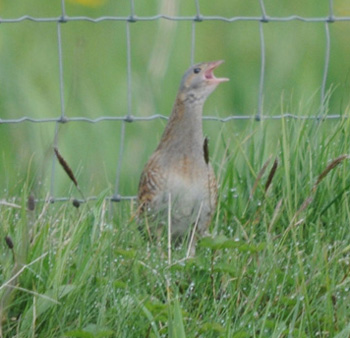 We set out at c09.30 for Balemartine via Balephetrish Bay and the airport, in the hope we might get better sightings of Corncrake. The bay contained the usual array of waders, terns, gulls and, of course, Great Northern Diver; we must have seen in excess of 40 divers whilst on the island as they lingered before returning north. At Balinoe Graveyard we spotted a single Lesser Redpoll amongst the Twite and Linnets and a little further on we saw a single Reed Bunting before turning on to the dead end road at Balemartine where we had been lucky yesterday. We spotted our first Stonechat here: we had expected to see this species yesterday, but none were to be found - today we spotted single birds and the occasional pair in most locations. We stopped the car in the same place we had previously seen Corncrake and almost immediately heard 2 birds calling, one on either side of the road. As I got out of the car with my camera I saw movement on a small bank at the side of the nearest small field and to my delight a Corncrake stood there, surveying the area and calling from time to time. After 2 or 3 minutes the bird returned to the undergrowth and we decided to move on, having enjoyed the moment immensely.
We set out at c09.30 for Balemartine via Balephetrish Bay and the airport, in the hope we might get better sightings of Corncrake. The bay contained the usual array of waders, terns, gulls and, of course, Great Northern Diver; we must have seen in excess of 40 divers whilst on the island as they lingered before returning north. At Balinoe Graveyard we spotted a single Lesser Redpoll amongst the Twite and Linnets and a little further on we saw a single Reed Bunting before turning on to the dead end road at Balemartine where we had been lucky yesterday. We spotted our first Stonechat here: we had expected to see this species yesterday, but none were to be found - today we spotted single birds and the occasional pair in most locations. We stopped the car in the same place we had previously seen Corncrake and almost immediately heard 2 birds calling, one on either side of the road. As I got out of the car with my camera I saw movement on a small bank at the side of the nearest small field and to my delight a Corncrake stood there, surveying the area and calling from time to time. After 2 or 3 minutes the bird returned to the undergrowth and we decided to move on, having enjoyed the moment immensely.
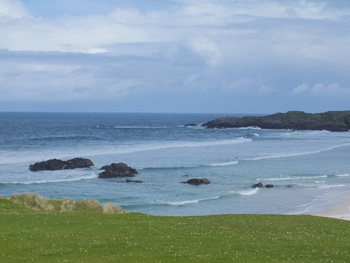 Pulling off the road near Hynish we saw several Eider and a couple of Rock Pipit along with a single Bar-tailed Godwit and a Curlew. Both Little and Arctic Tern were roosting on the rocks and of course 3 or 4 Great Northern Divers fishing off-shore. We decided to head towards Balephuil next and, hearing Corncrake calling once again, we stopped briefly, just in time to see the bird as it scurried into the long grass. We parked up overlooking Balephuil Bay: the sea was nowhere near as calm on this stretch of the coast and for once the number and quality of birds did not match the beautiful scenery. 2 Razorbill and c20 Gannet were all we could manage, apart from a few assorted gulls, so after about 20 minutes we decided to return to Scarinish for a spot of lunch and then move on again across the island to Balevullin Bay, where we were told a large Basking Shark had been spotted earlier in the week. This was our second visit here, but we had no luck with the shark. We did however enjoy close-up views of c20 each of Dunlin and Turnstone and c6 Purple Sandpiper as they scuttled across the rocks and ferreted about in the glistening seaweed. This visit was quite productive as we also saw Red-throated Diver, 2 Whimbrel, 2 Common Scoter, a single Guillemot and 2 Razorbill, whilst on our walk to the shore-line we were almost tripping up over Wheatear and both Pied and White Wagtails.
Pulling off the road near Hynish we saw several Eider and a couple of Rock Pipit along with a single Bar-tailed Godwit and a Curlew. Both Little and Arctic Tern were roosting on the rocks and of course 3 or 4 Great Northern Divers fishing off-shore. We decided to head towards Balephuil next and, hearing Corncrake calling once again, we stopped briefly, just in time to see the bird as it scurried into the long grass. We parked up overlooking Balephuil Bay: the sea was nowhere near as calm on this stretch of the coast and for once the number and quality of birds did not match the beautiful scenery. 2 Razorbill and c20 Gannet were all we could manage, apart from a few assorted gulls, so after about 20 minutes we decided to return to Scarinish for a spot of lunch and then move on again across the island to Balevullin Bay, where we were told a large Basking Shark had been spotted earlier in the week. This was our second visit here, but we had no luck with the shark. We did however enjoy close-up views of c20 each of Dunlin and Turnstone and c6 Purple Sandpiper as they scuttled across the rocks and ferreted about in the glistening seaweed. This visit was quite productive as we also saw Red-throated Diver, 2 Whimbrel, 2 Common Scoter, a single Guillemot and 2 Razorbill, whilst on our walk to the shore-line we were almost tripping up over Wheatear and both Pied and White Wagtails.
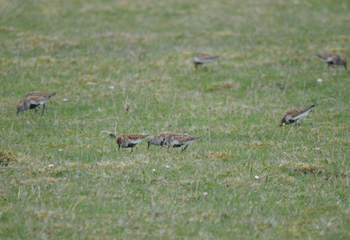 We stopped at Loch Basapol next: a Windsurfing School use the loch and previously we had not seen anything here. Perversely two or three people were having some training lessons on the water and this time there were gulls, terns and Swallows around whilst on the water were a couple of swans and a few Tufted Duck. It is difficult to get close up views of most of the machair lochs, and not having seen much on the water previously, we paid the price for getting lazy: we must have passed Loch an Eilein two or three times during the day but we didn’t get our scopes out and missed an American Wigeon and a single Pink-footed Goose which had been located there today.
We stopped at Loch Basapol next: a Windsurfing School use the loch and previously we had not seen anything here. Perversely two or three people were having some training lessons on the water and this time there were gulls, terns and Swallows around whilst on the water were a couple of swans and a few Tufted Duck. It is difficult to get close up views of most of the machair lochs, and not having seen much on the water previously, we paid the price for getting lazy: we must have passed Loch an Eilein two or three times during the day but we didn’t get our scopes out and missed an American Wigeon and a single Pink-footed Goose which had been located there today.
Having achieved our main objective with good sightings of Corncrake, we spent the rest of the afternoon gently tooling around the island, enjoying the birds and the scenery, before finishing up once again at Gott Bay and then Balphetrish Bay for one last look at the waders and divers we knew we would find there. We dined once again at the Céabhar Restaurant at Sandaig.
Friday 9th May: Tiree & 09.20 ferry to Oban (arrived at 13.15) and journey south - o/n Dumfries.
We needed to check in for the ferry at 08.35 so our last breakfast at Rockvale was a little earlier than usual. The subsequent long wait in the car by the ferry pier allowed final glimpses of several Great Northern Divers out in the bay, whilst the occasional Gannet passed by and a few Dunlin & Ringed Plover fed on the rocks and beach below the pier. On the ferry we spent most of our time inside, in comfort, rather than out on the deck as we hadn’t seen much on the outward journey. Nevertheless we still saw 5 Common Scoter, numerous Shag and Arctic Terns, a single Guillemot, 4 Razorbill and a distant Golden Eagle; a pair of Red-throated Diver flew by the ferry and landed on the water nearby. Back on dry land, we headed south and after a late lunch at Tyndrum we made our way to Dumfries.
Saturday 10th May: Dumfries to Gate of Fleet and return home.
This morning we visited a couple of gardens and plant nurseries before returning home. As we left Dumfries we spotted our first 3 Swift of the year as they flew over a roadside farmhouse. At our first stop near Kirkcudbright the garden was full of the sound of Chiffchaff, Willow Warbler, Blackcap, Wren and Song Thrush whilst a single Buzzard and Swallows flew above. We also heard similar song at our second stop at Gate of Fleet and saw a lone Red Kite prospecting overhead. Having bought a few new plants we eventually decided it was time to return home.
SUMMARY
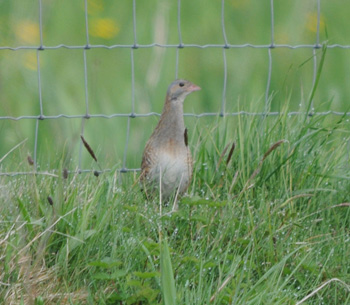 Not only did we achieve our main objective with good sightings of Corncrake, we also saw some more common winter visitors, resplendent in their summer plumage and enjoyed close views of breeding Snipe, Twite, Redshank and Wheatear. Life on Tiree is peaceful, if a little windy and the island has some beautiful beaches and an interesting coastline to enjoy. We were well looked after at the excellent Rockvale Guest House and enjoyed some good food and hospitality at the Céabhar Restaurant.
Not only did we achieve our main objective with good sightings of Corncrake, we also saw some more common winter visitors, resplendent in their summer plumage and enjoyed close views of breeding Snipe, Twite, Redshank and Wheatear. Life on Tiree is peaceful, if a little windy and the island has some beautiful beaches and an interesting coastline to enjoy. We were well looked after at the excellent Rockvale Guest House and enjoyed some good food and hospitality at the Céabhar Restaurant.
Notwithstanding all the plusses Tiree will not be on our list of places we must re-visit, as after two days we had explored almost every road on the island and we prefer to seek out new places and experiences. We saw 64 bird species on the island and the ferry journeys and on the overall trip we saw a total of 92 species (plus Cuckoo & Chiffchaff heard only). One lifer only; but as that was the main reason for visiting Tiree we were well pleased with the result and we had an enjoyable break into the bargain.
Bird Species Trip List
Bird Photos
Trip Report PDF file
David & Amanda Mason
